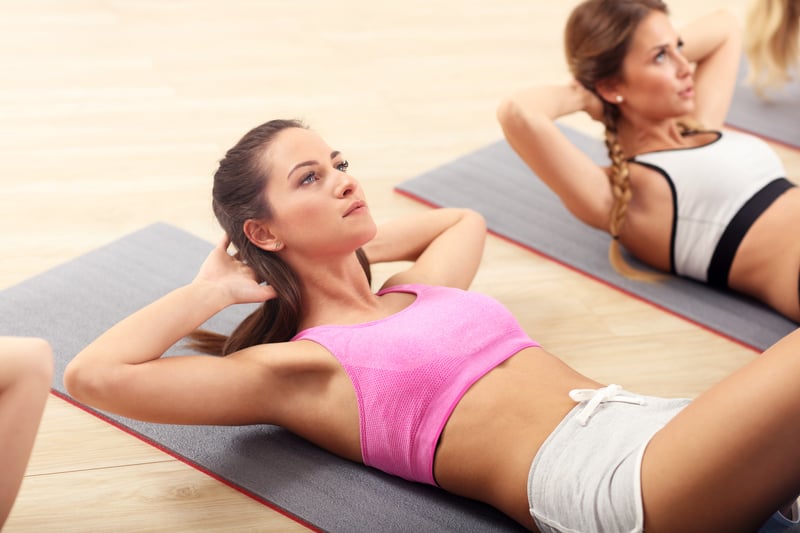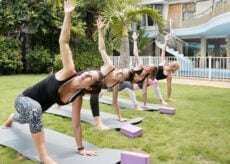6 Worst Exercises You Should NEVER Do (do these instead)

Not all exercises are created equal. Just because you’re working out doesn’t mean you’re doing something good for yourself. In fact, some exercises could do more harm than good. Here are 6 of the worst exercises you can do, why you want to avoid them, and what you can do instead:
The 6 Worst Exercises: Don’t Do These
1. Upright Rows—this exercise is a shoulder injury waiting to happen. Expanding the width and size of your shoulders can give you the illusion of a smaller waist. Think back to the bygone era of shoulder pads; well, this is the same idea minus the ‘80s wardrobe. This coveted look is attainable through hard, diligent work over time, but exercising your shoulders the wrong way can set you back months, if not years.
This exercise typically has you standing and grasping a barbell in front of you. You then raise your arms with your elbows flared out to the sides to lift the bar.
I’m sure you see people doing this exercise at the gym all the time. But, the fact remains that this is possibly one of the most worst exercises you can do for your shoulders. This movement causes your shoulders to rotate internally. Once you add heavy weight to the equation, it spells disaster. You can easily impinge your shoulder and irritate or even tear your rotator cuff.
2. Triceps Dips on a Bench—this is yet another exercise which puts undue stress on your shoulder girdle. Everyone in the gym wants to improve their arms and get that nice, toned look that includes nicely defined biceps, triceps, and shoulders, but this is one exercise that should be avoided.
This exercise entails you sitting on the side of a bench and placing your palms forward on either side of your hips or directly under your butt. Your feet and legs are typically straight out in front of you on the floor, or some folks will put them up on another bench. Next, you scoot forward until your hips drop off the bench. Bending your elbows back, you lower your rear end toward the floor and then raise back up by straightening the arms. As innocent as this looks, this exercise has a big potential to send you to the orthopedic surgeon because of the strain placed on the front of your shoulders during this movement.
3. Traditional Sit-ups—yes, you read that right. Old-fashioned sit-ups are one of the worst exercises you can do, and your father’s (or grandfather’s) traditional “sit-up” puts a lot of stress on your neck and is not that beneficial when it comes to working your abs.
You’ll often see people performing a sit-up with their feet secured under an object. With a rounded back, they yank their heads forward with their hands as they attempt to curl upward into a sitting position. This movement has been shown to not only strain the neck, but it also has the potential to increase lumbar spine loading, which can lead to lower back injury and pain.
4. Behind-the-Neck Pulldowns—these are very hard on your shoulders. Plus, they’re not that effective. While seated on a bench and grasping the lat pulldown bar with both arms outstretched above you, you pull the bar behind your head instead of in front of it. This causes your shoulders to roll back into an unnatural position and puts massive strain on this delicate joint. Not only that, but this movement forces you to thrust your head and neck forward, causing additional strain.
5. Jumps—yes, jumps can be great for ramping up your lower body power and increasing intensity, but for most of us, jumps put too much stress on the knees, back, and ankles. You may be incorporating jumps into a variety of workout regimens, but jumper beware: you’re putting a huge amount of stress on your joints, bones, muscles, tendons, and ligaments every time you land.
6. Dips—this is yet another incredibly popular exercise regularly seen in gyms across the country. You’ll see people on a dip machine with their arms grasping a bar on either side of them and then lowering their bodies downward and back up again. A combination of things can cause injury, including poor form (which is rampant), going too heavy, doing too many repetitions, or even just by aggravating previous injuries, and possibly increasing inflammation. Doing dips can exacerbate the situation, and it’s easy to go from bad to worse when it comes to injury with all the stress placed on your shoulder joints.
Just because you happen to see people (even trainers or people in great shape) doing these 6 worst exercises who don’t appear to be injured is not a good reason to try to emulate them. They could have very strong supporting musculature that you may not have, they may have had surgery for an injury already, or they may simply not know any better. Most likely, they are, indeed, another injury waiting to happen.
Do These Exercises Instead
Now that you know which are the worst exercises, you still want a great workout. Here’s what to do instead!

1. Instead of the Upright Rows, try Hammer Dumbbell Overhead Presses. From a standing position, grasp a dumbbell in each hand. Bend your elbows so your arms are parallel to the ground and keep the ends of the dumbbells facing forward and your palms facing each other. Keeping your abdominals tight and your spine neutral, press upward until your arms are straightened, without locking out your elbows, and then return to parallel by bending your elbows.
This type of movement will help you reduce strain on your shoulder girdle while strengthening the area, without exposing it to potential injurious forces.

2. Instead of Triceps Dips on a Bench, try doing Close-Grip Bench Presses. While lying on your back on a bench, grab the bar with your hands with a moderately narrow grip. Don’t put your hands too close together, or you’ll strain your elbows, but do keep them no more than shoulder-width apart. Focus on using your triceps muscles to lower the bar in a controlled manner to your chest, and use them to push it back up to starting position.

3. Instead of Sit-Ups, try doing Stability Ball Crunches. What’s the difference? This is a core stabilization movement. By doing crunches on a stability ball, you’ll vastly improve the effectiveness of the movement. Because sitting on a stability ball allows for your body to move in several planes, it forces you to engage your abdominals more fully. A crunch is basically a partial sit-up in which you squeeze your abdominal muscles enough to perform the movement and keep constant tension on the region throughout the exercise. Focus on curling your torso rather than sitting up, and pull in your belly button throughout the exercise.

4. Instead of Behind-the-Neck Pulldowns, try sticking to Front Pulldowns. While sitting and facing forward on a lat pulldown machine, grab the pulldown bar with your palms facing forward and your hands placed at least shoulder-width apart. In a controlled manner, pull the bar toward your upper chest while maintaining an upright seated position. Hold for a moment and squeeze your elbows and shoulder blades. Return to start and repeat.

5. Instead of Jumps, just Take it Down a Notch. You don’t need the jumping motion to benefit from the movement. Instead of jumping up onto the box, try stepping up onto the box; instead of doing jump squats, just squat slowly, and enjoy the burn. The less sudden stress you can put on your legs, knees, and ankles, the better. Stepping up and down slowly will still garner serious benefits without the risk of serious injury.

6. Dips—just Don’t. In this case, instead of doing dips to improve your chest, shoulders, and triceps, try doing Pushups. Pushups are a compound exercise and will engage not only your biceps, triceps, and shoulders but your chest, back, abs, and even, to a certain degree, your legs. Because pushups involve so many muscle groups, they burn a lot of calories and will help to strengthen, tone, and define your upper body and core. These are a win-win with little stress on your joints.
Now, enjoy the results from your time in the gym knowing you’re helping protect your body from the worst exercises that could lead to sudden or chronic joint pain or injury.






